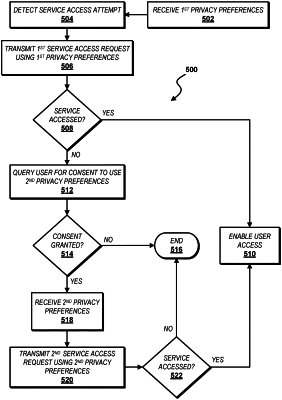| CPC H04L 63/102 (2013.01) [G06F 16/9535 (2019.01); G06F 21/6263 (2013.01)] | 21 Claims |

|
1. A method comprising:
receiving first privacy preference parameters of a user, the first privacy preference parameters comprising at least one of a first indication of whether the user will share personally identifiable information (“PII”), a first indication of whether the user will accept tracking cookies, a first indication of whether the user will allow being tracked, a first indication of whether the user will share browsing history, or a first indication of whether the user will receive ads;
detecting a first attempt by the user via a computing device to access a service enabled by a computing system via a network;
transmitting via the network to the computing system a first request to access the service using the first privacy preference parameters of the user in response to detecting the first attempt by the user to access the service;
determining a failure to access the service, the failure to access the service responsive to the first request;
querying the user for consent to access the service using second privacy preference parameters, the second privacy preference parameters comprising at least one of a second indication of whether the user will share PII, a second indication of whether the user will accept tracking cookies, a second indication of whether the user will allow being tracked, a second indication of whether the user will share browsing history, or a second indication of whether the user will receive ads;
receiving from the user the consent to access the service using the second privacy preference parameters;
receiving the second privacy preference parameters of the user;
transmitting via the network to the computing system a second request to access the service using the second privacy preference parameters in response to receiving from the user the consent to access the service using the second privacy preference parameters;
receiving first access to the service from the computing system for the user;
detecting a second attempt, subsequent to the first attempt, by the user via the computing device to access the service enabled by the computing system via the network;
transmitting via the network to the computing system a third request to access the service using the second privacy preference parameters in response to detecting the second attempt by the user to access the service; and
receiving second access to the service, subsequent to the first access to the service, from the computing system for the user.
|